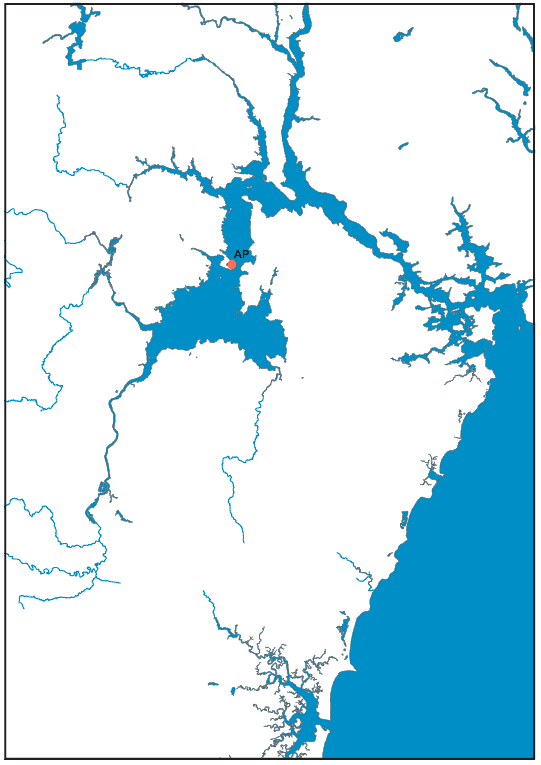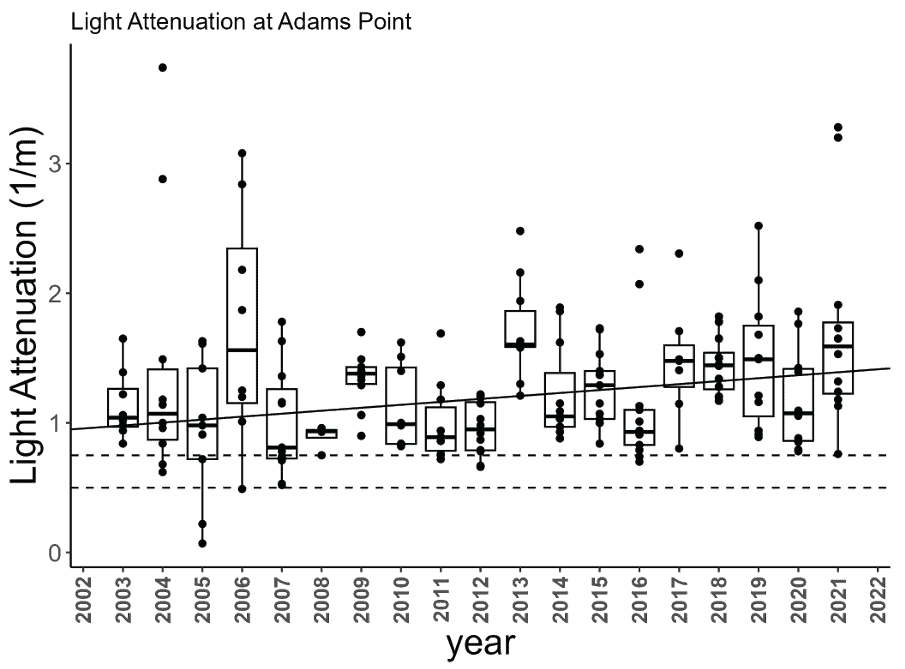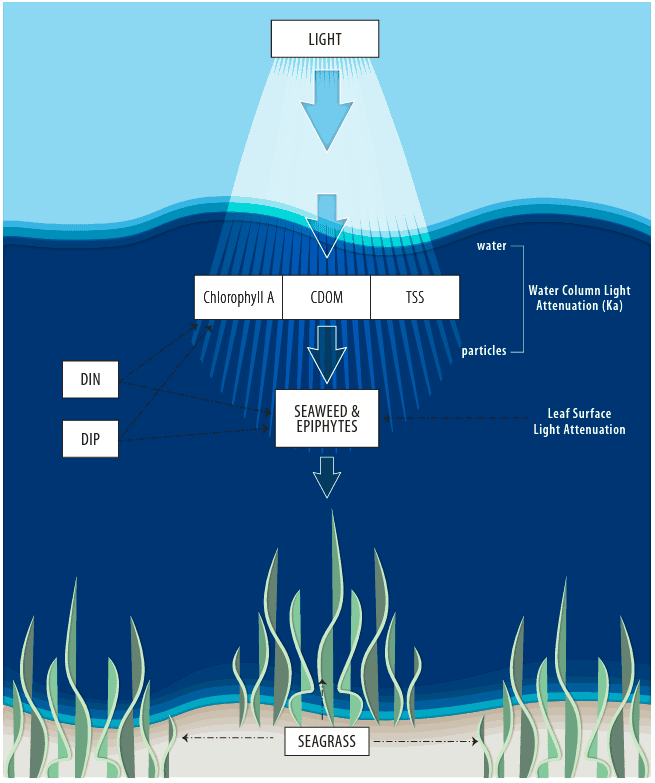Light
Migratory Fish Restoration
What are the underwater light conditions and how have they changed over time?
As often happens in estuaries, light penetration is greater at the mouth of the Great Bay Estuary than in the upper portions of the estuary, where light frequently does not meet eelgrass requirements. At Adams Point, where data collection began in 2003, there is a statistically significant increasing trend in light attenuation (reduction) pointing to worsening light conditions. The two main constituents that attenuate light — total suspended solids and phytoplankton — have increased since 1988 at Adams Point, with total suspended solids decreasing in recent years. In the Hampton-Seabrook Estuary, light attenuation data has been collected since 2018, and values are comparable to Adams Point.
This section focuses on the Great Bay Estuary due to the connection between light and eelgrass. Eelgrass habitat is not present in the Hampton-Seabrook Estuary, but light attenuation data has been collected there since 2018. Currently, light attenuation values at the Hampton River Station are comparable to the values in the Great Bay Estuary, described below.
It is well known that eelgrass in the Great Bay Estuary has struggled since its peak in 1996. Very often, eelgrass disappears because light conditions have degraded. This is worrisome because it could lead to an undesirable feedback loop, where less eelgrass leads to less stable sediments and reduced filtering of nutrients, which leads to worsening light conditions and the loop continues.
In the Great Bay Estuary, our longest time series of light data starts in 2003 at the Adams Point Station (Figure 14.1), and these data indicate a statistically significant increasing trend for light attenuation (Figure 14.2). “Light attenuation” or “Kd” refers to the loss of light as water gets deeper. So, low values indicate more light is penetrating deeper. There are no trends in light attenuation at other stations, possibly due to not having as many years of data. Unfortunately, none of our light attenuation data extend back to the time when eelgrass was more abundant (1996).
In 2009, the NHDES report, Numeric Nutrient Criteria for the Great Bay Estuary suggested a range of light attenuation values (0.5/m to 0.75/m) for the maintenance of existing eelgrass beds, depending on how deep the beds are.42 A peer review of this document noted that these attenuation targets could actually be too high — i.e., light attenuation needs to be less, so more light penetrates the water column — given that eelgrass loss has already occurred, and that better conditions are required for recovery as compared with “maintenance.”43 For the deeper beds (~3 m) in Portsmouth Harbor, lower light attenuation (i.e., higher penetration) is necessary because the light has to travel through more water to reach the eelgrass. For the meadows in Great Bay proper, light attenuation values as high as 0.75/m were deemed acceptable because the plants are only expected to grow in water 2 m deep.
In Portsmouth Harbor, between 2004 and 2017, the median light attenuation value is 0.61/m. In the Upper Piscataqua River, between 2007 and 2020, the median value is 1.30/m. At Adams Point (Figure 14.2), between 2003 and 2021, the median light attenuation value is 1.2/m, and very few data points in recent years are below the threshold of 0.75/m. The high number of data points above 1.0/m and approaching 2.0/m suggests that light is a serious concern in terms of eelgrass recovery and perhaps even for basic maintenance of current levels.
Given the concern about light, the next step is to look at the things that can attenuate light in the Great Bay Estuary. The three main controls of light in estuaries are total suspended solids, chlorophyll-a (a proxy for phytoplankton), and colored dissolved organic matter. By looking closely at the levels of these constituents at various places in the Great Bay Estuary, managers can see what changes they will need to make to improve light conditions for eelgrass. Usually, phytoplankton is the most amenable to change through control of nutrients, even if it is not the highest attenuator of light. Colored dissolved organic matter is more difficult to manage as it is mostly derived from decomposing leaves and other plant material delivered by rivers. For these reasons, phytoplankton management thresholds are often lower for systems with higher total suspended solids values.
Adding more complications to an already complex topic, it is important to understand that light can be attenuated in other ways (Figure 14.3). “Epiphytes” — algae or plant matter that grow on other plants — often grow on the eelgrass blades, especially when grazers are not abundant or nutrients (e.g., nitrogen) are high. Also, seaweeds can grow inside, around, and on top of eelgrass beds, blocking light and adding organic matter to the sediments. In the estuaries around Prince Edward Island, Canada, for example, scientists found that eelgrass was impacted by seaweed proliferation, fueled by nitrogen from agricultural runoff. However, light attenuation measured in the water column never changed.
Total suspended solid levels have been declining in recent years while there was no clear pattern in phytoplankton levels (see “Total Suspended Solids” and “Phytoplankton”). In 2021, a 3-year project began with the goal of better understanding the relationship between nutrients and sediments and how these constituents relate to light, eelgrass, seaweeds, phytoplankton, and epiphytes.
Acknowledgments and Credit
Kalle Matso (PREP) with contributions from Lara Martin (UNH).

Figure 14.1: Monitoring station for light at Adams Point (AP) Data source: Jackson Estuarine Lab, UNH

Figure 14.2: Light attenuation (Kd) data at Adams Point, 2003 through 2021. Data are log-transformed and include a mix of high and low tide samples, with all samples taken between April 1 and August 30 of the given year. Boxes encompass the middle 50% of the data points. The horizontal line in each box is the median and the vertical whiskers encompass the remaining data. “Outliers” are shown as individual points. Lines at 0.5/m and 0.75/m refer to suggested range of light attenuation values for the maintenance of existing eelgrass beds. The trend line indicates a statistically significant increasing relationship over time. Data source: Jackson Estuarine Lab, UNH

Figure 14.3: This image, adapted from the Long Island Sound Study, “Habitat Restoration Initiative,” illustrates the interactive effects of nutrients and living resources on light penetration including Dissolved Inorganic Nitrogen (DIN) and Dissolved Inorganic Phosphorus (DIP), Colored Dissolved Organic Matter (CDOM), and Total Suspended Solids (TSS). Grazers include fishes and invertebrates that feed on the algae that can grow on eelgrass leaves. Data source: Long Island Sound Study